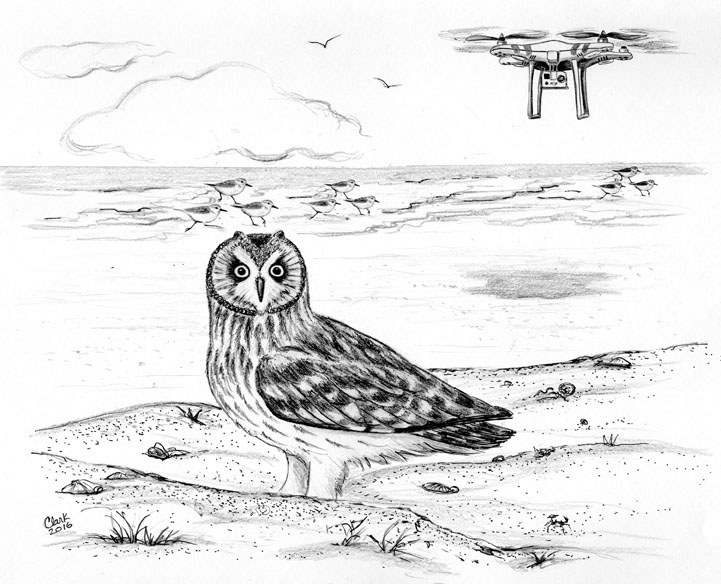
Dear Bird Folks,
Last week I was flying my remote controlled drone over the beach when an owl (see video clip) flew out from the dune grass. Can you tell what kind of owl it is?
– Bradley, Hyannis, MA
Uh-oh, Bradley,
Two years ago my wife gave me a drone for Christmas and told me that I could return it if I didn’t want it. I brought it back. Typically I like new gadgets, but I wasn’t sure about this one. After seeing your cool owl video, however, I’m starting to have second thoughts. Maybe I should ask my wife to buy me another one. Nah. The beach birds already have enough problems. The last thing they need is a flying robot buzzing them from above. It’s bad enough that beach birds have to avoid fisherman, loose dogs, sunbathers…and recently, camels.
Your high-tech birding methods aside, seeing a Short-eared Owl is a real treat. This is because Short-eared Owls have become scarce on Cape Cod. That’s too bad because Short-eared Owls are one of the few owls that are fairly easy for us to see. Shorties (“shorties” are what birders, and writers with tired fingers, call Short-eared Owls) frequently hunt at sunset. Back in the ‘70s, I would regularly stop at West Dennis Beach or Coast Guard Beach in hopes of seeing one of these fascinating birds as it headed out on its evening hunt. I could never have imagined how scarce they would be, or that that the best way to see one would be from a drone. Back then drones were just bees (and fortunately for readers, the newspaper won’t let me write about both the birds and the bees).
Why Short-eared Owls have vanished from our area isn’t totally clear, but as usual the finger points towards changes in their habitats. Throughout their range shorties are found in an assortment of open areas, including tundra, prairies, and coastal grasslands. Because they live in a tree-less world, these owls tend to hunt on the wing and not from a perch. They fly low over the ground and use their highly developed hearing to listen for the squeak of a mouse or the rustle of a scurrying vole. Because of this distinctive style, it’s hard to confuse a hunting Short-eared Owls with any other owl. Their flight is buoyant and erratic, and looks very much like a moth…a really big moth. (BTW: Don’t go looking for the “ears” on a Short-eared Owl; only occasionally are their ear tufts seen, and even then they look more like cowlicks than ears.)
Owls of the deep woods need to vocalize in order to find a mate, which is why they “hoot” or call loudly. But the traditional “hooting” we associate with woodland owls does not apply to shorties. Living in the open allows them to use their flight skills to get a mate’s attention. Male Short-eared Owls are known for their elaborate courtship displays or “sky dance,” in which they use conspicuous wing flaps and diving to impress the ladies. This dance might seem a little strange to us, but I think we’ve all done something equally awkward in an effort to attract a mate. I know I have.
Usually when we disturb a bird it flies away and doesn’t really look at us. But such is not always the case with owls. One winter I was walking across a dune in Chatham when I flushed a Short-eared Owl. Instead of flying away, it flew around me and kept staring me right in the eyes. Unlike other birds, which have eyes on the sides of their heads, owls have front-facing eyes, just like we do. As I watched the bird circle, it stared right back at me, shooting me the “skunk eye” the entire time. (I get that a lot.)
Owls are great hunters, in part because they have keen vision and superior hearing. But there is one thing they aren’t good: building nests. In fact, they are the ultimate squatters. When owls find a place that looks like an acceptable location to raise a family (usually an old crow or woodpecker nest), the female simply lays her eggs. She doesn’t bother gathering material or even forming a “cup.” She merely cranks out her eggs and begins to incubate them. But Short-eared Owls lay their eggs right on the cold ground and thus can use a little insulation. When I was growing up my mother used to tell me not to “sit on the damp ground.” I’m not sure why, but maybe she was afraid I’d get chilblains or lumbago, or whatever disease was going around back then. Well, Short-eared Owls must have heard her because they are one of the few owls that build a nest. The female scrapes a shallow impression on the ground and then lines it with grass and feathers. This way Mrs. Owl ensures her owlets won’t come down with chilblains or lumbago, which, of course, can be a big problem for owls.
Even though the population of Short-eared Owls has been dropping, on the whole they are a very successful species. Shorties can be found on five continents and in all fifty U.S. states, including Hawaii. How did they get to Hawaii? Short-eared Owls are strong flyers. At some point a few adventurous birds left, perhaps, Alaska and landed in Hawaii. Once they got there, they didn’t want to leave…and I don’t blame them.
I’m glad you found a Short-eared Owl, Bradley, but don’t get too carried away with that drone of yours. Birds are under enough stress, especially during the breeding season. Instead, use your drone to photograph sunbathers, or camels…or sunbathers riding camels. Yeah, do that last one.